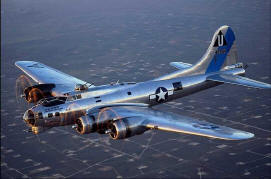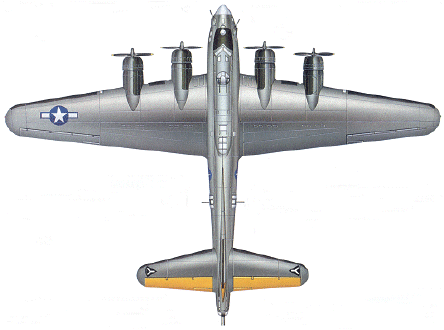

Plane type: 4-engined heavy Bomber
Manufacturer: Boeing
Crew: 9
Dimensions
Length: 74ft 4in (22.78 meters)
Height: 19ft 1in (5.85 meters)
Wingspan: 103ft 9in (31.6 meters)
Powerplant
B-17B : 4 x 1000 h.p. Wright R-1820-51 engines with exhaust driven turbochargers
B-17C: 4 x 1200 h.p. Wright R-1820-65 engines
B-17D: no engine modification
B-17E: no engine modification
B-17F: Late models fitted with 4 x R-1820-97 engines
B-17G: 4 x R-1820-97 Cyclone radial piston engines
CLICK HERE to read up on the Wright R-1820 engine
Weight
Empty weight: 32720 lbs (14855 kg)
Normal loaded weight: 49500 lbs (22475 kg)
Maximum overloaded weight: 60000 lbs (27240 kg)
Armament (B-17G)
Armament: Thirteen 50 cal. machine guns
-2 x remote-controlled in chin turret beneath plastic nose (bombardier compartment)
-2 x cheek mountings (one on either side of plastic nose)
-2 x in electrically operated turret on top of fuselage, just aft of pilots cockpit
-1 x hand-operated gun firing through top of fuselage, above radio operator
-2 x in electrically operated ball turret below fuselage
-2 x hand-operated in side ports, one on each side of fuselage
-2 x in tail gun
Bomb load: 6000 lbs (2724 Kg)
Performance (B-17G)
Maximum speed: 297 mph (472 Km/h) @ 25000ft
Range (max. bomb load & normal fuel): 1100 miles (1760 km) @ 220 mph (352 km/h) @ 25000ft (7625 m)
Ceiling: 35000ft (10670 m)
Notes:
Acknowledged as one of the most famous aircraft of aviation history, the B-17 Flying Fortress first rolled into the world as the Model 299, produced by Boeing. After many versions, successes, and failures, the B-17G "Flying Fortress" was the most famous bomber of WWII. Although it often overshadowed its counterpart in fame, the B-24 Liberator, the Fortress was definitely worthy of the selection by the AAF (Army Air Forces/Corps) to be the primary bomber of the war.
The "Fortress" was most honored for its ability to bring the crew back safely. After hard flak hits (See B-17 Battle Damaged album below) the plane would survive the trip back, even if it ended up crashing on the runway. This aspect of the plane, along with its exceptionally long range, the bomb load capacity, effectiveness in combat and the ease of flying, was what made the "Fortress" extremely popular among bomber crews. Supposedly 2 out of every 5 bombs dropped were by the B-17 Flying Fortress.
"As an aviation enthusiast myself, I think of the B-17 as one of the greatest planes of the war." -Bryce McKibben
RESOURCES:
Page #1 - The Flight Line
Page #2 - Warbird Resource Group
Page #3 - USAF Museum
Page #4 - Homepage of WW2 Aircraft
Page #5 - Aviation History On-line

![]()
Pictures: